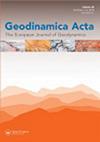土耳其西北部西Sakarya基底哈夫兰单元的成因与演化:LA-ICP-MS U-Pb定年及可能与Avalonian微大陆的联系
IF 1.5
Q1 Earth and Planetary Sciences
引用次数: 31
摘要
哈夫兰单元是西萨克里亚带(土耳其西北部)的前侏罗世变质基底之一,包含变质沉积岩(即卡拉巴克组)和泥盆纪变质岩。为了更好地了解卡拉巴克组的起源和演化,对某变质沉积岩中125粒锆石进行了LA-ICP-MS U-Pb定年研究。175个样品中有107个样品的锆石年龄在426±5.2 ~ 3406.9±195.7 Ma之间。锆石种群分布范围:426±5.2-535±13 Ma(古生代8.4%)、549±14-999±11 Ma(新元古代54.21%)、1012±200-1543±50 Ma(中元古代6.54%)、1736±123-2414±58 Ma(古元古代18.7%)和2512±30-3406.9±195.7 Ma(太古宙12.15%)。新元古代占主导地位,卡多米亚-阿瓦隆时期和中元古代主要与阿瓦隆时期有关。卡拉卡贝变质花岗岩由粗粒、等粒、半自形、很少叶状的二长花岗岩和花岗闪长岩组成。它位于比加半岛东部卡拉卡贝镇的北部。主要矿物组合为石英、钾长石、斜长石、黑云母。锆石、磷灰石、独居石、磁铁矿和榍石为副相。铝饱和度指数(ASI)在0.91 ~ 1.63之间变化,表明该岩体为金属-过铝型花岗岩。在SiO2 / K2O图上,偏长花岗岩样品被绘制在高钾钙碱性场中。n - morb归一化蜘蛛图显示大离子亲石元素(LILE)、轻稀土元素(LREE)富集,而高场强元素富集,表明其成因与俯冲带地幔楔的水熔融和/或俯冲带影响的源区熔融有关。球粒陨石正态化稀土元素蜘蛛图表明斜长石和角闪孔分馏的重要性。在构造判别图上,所有的变长花岗岩样品均落在火山弧花岗岩和晚碰撞后花岗岩场中。U/Pb LA-ICP-MS锆石测年结果显示,该辉长岩年龄为4000.3±1.4 Ma(早泥盆世),为火成岩结晶年龄。这些年龄数据表明,卡拉卡贝变质花岗岩属于新近在比加半岛发现的下至中泥盆世花岗岩。根据这些发现,我们认为哈夫兰单元是一个奇特的地形,可能曾经是遥远的阿瓦隆地形的一部分,并附属于萨卡里亚区。本文章由计算机程序翻译,如有差异,请以英文原文为准。
Origin and evolution of the Havran Unit, Western Sakarya basement (NW Turkey): new LA-ICP-MS U-Pb dating of the metasedimentary-metagranitic rocks and possible affiliation to Avalonian microcontinent
One of the pre-Jurassic metamorphic basements of the Western Sakarya Zone (NW Turkey) is the Havran Unit which contains metasedimentary (i.e. the Kalabak formation) and metaintrusive rocks of Devonian age. An LA-ICP-MS U-Pb zircon dating study was conducted on 125 zircon grains obtained from a metasedimentary rock to better understand the origin and evolution of the Kalabak formation. Around 107 of 175 spot analyses are concordant with rates 90–110% and the zircon ages vary between 426 ± 5.2 and 3406.9 ± 195.7 Ma. Zircon populations cluster in ranges: 426 ± 5.2–535 ± 13 Ma (8.4%, Palaeozoic), 549 ± 14–999 ± 11 Ma (54.21%, Neoproterozoic), 1012 ± 200–1543 ± 50 Ma (6.54%, Mesoproterozoic), 1736 ± 123–2414 ± 58 Ma (18.7%, Palaeoproterozoic), and 2512 ± 30–3406.9 ± 195.7 Ma (12.15%, Archean). Dominating Neoproterozoic ages notate Cadomian-Avalonian terrains and Mesoproterozoic ages should mainly be related to Avalon terrains. The Karacabey metagranite consists of coarse-grained, equigranular, hypidiomorphic, and rarely foliated monzogranite and granodiorite. It is located to the north of the town of Karacabey in the eastern part of the Biga Peninsula. Main mineral assemblage is quartz, K-feldspar, plagioclase, and biotite. Zircon, apatite, monazite, magnetite, and sphene occur as accessory phases. Aluminum Saturation Index (ASI) values vary between 0.91 and 1.63, indicating the pluton as a metaluminous-peraluminous, I-type granite. The metagranite samples are plotted in the high-K-calcalkaline field on the SiO2 vs. K2O diagram. N-MORB-normalised spidergrams display a profound enrichment in the large-ion lithophile elements (LILE), light rare earth elements (LREE), and depletion in high field strength elements, suggesting that its genesis relates to hydrous melting of a mantle wedge in a subduction zone and/or melting of subduction zone-influenced source areas. Chondrite-normalised rare earth element spidergrams are indicative of the importance of plagioclase and amphibole fractionation. In tectonic discrimination diagrams, all of the metagranite samples fall into the volcanic arc granite and late post-collisional granite fields. U/Pb LA-ICP-MS zircon dating of the metagranite yielded an age of 400.3 ± 1.4 Ma (Early Devonian), interpreted as the age of igneous crystallisation. These age data show that the Karacabey metagranite is a member of the lower to mid Devonian granites, recently described from the Biga Peninsula. In light of these findings, we argue that the Havran Unit was an exotic terrain which possibly was once a part of far-travelled Avalon terrains and was attached to Sakarya Zone.
求助全文
通过发布文献求助,成功后即可免费获取论文全文。
去求助
来源期刊

Geodinamica Acta
地学-地球科学综合
CiteScore
4.50
自引率
0.00%
发文量
0
审稿时长
25 weeks
期刊介绍:
Geodinamica Acta provides an international and interdisciplinary forum for the publication of results of recent research dealing with both internal and external geodynamics. Its aims to promote discussion between the various disciplines that work on the dynamics of the lithosphere and hydrosphere. There are no constraints over themes, provided the main thrust of the paper relates to Earth''s internal and external geodynamics. The Journal encourages the submission of papers in all fields of earth sciences, such as biostratigraphy, geochemistry, geochronology and thermochronology, geohazards and their societal impacts, geomorphology, geophysics, glaciology, igneous and metamorphic petrology, magmatism, marine geology, metamorphism, mineral-deposits and energy resources, mineralogy, orogeny, palaeoclimatology, palaeoecology, paleoceanograpgy, palaeontology, petroleum geology, sedimentology, seismology and earthquakes, stratigraphy, structural geology, surface processes, tectonics (neoteoctonic, plate tectonics, seismo-tectonics, Active tectonics) and volcanism.
Geodinamica Acta publishes high quality, peer-reviewed original and timely scientific papers, comprehensive review articles on hot topics of current interest, rapid communications relating to a significant advance in the earth sciences with broad interest, and discussions of papers that have already appeared in recent issues of the journal. Book reviews are also included. Submitted papers must have international appeal and regional implications; they should present work that would be of interest to many different specialists. Geographic coverage is global and work on any part of the world is considered. The Journal also publishes thematic sets of papers on topical aspects of earth sciences or special issues of selected papers from conferences.
 求助内容:
求助内容: 应助结果提醒方式:
应助结果提醒方式:


